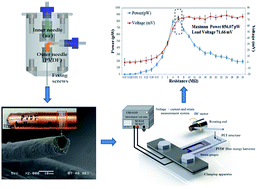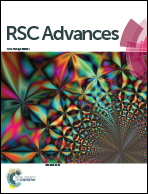Near-field electrospinning enhances the energy harvesting of hollow PVDF piezoelectric fibers†
Abstract
In this study we used the near-field electrospinning (NFES) process with the metallic coaxial needle injector to fabricate piezoelectric poly(vinylidene fluoride) (PVDF) hollow fiber tubes. Using these tubes, we designed an energy capture device featuring parallel electrodes to harvest low-frequency energy. We examined the effects of several parameters on the properties of the piezoelectric PVDF fiber tubes (PPTs), including the core flow rate, shell flow rate, concentration of PVDF, rotating tangential speed, and electric field. The elongation of the PPTs was greater than that of solid PVDF fibers, with the tensile strength of the PPTs reaching 32.49 MPa (as determined through a micro-tensile measurement). The output voltage of the PPTs was considerably higher (71.66 mV) and, with an external load resistance of 6 MΩ, the output power was also significantly greater (856.07 pW) than the solid PVDF fiber (output voltage = 45.66 mV and the maximum output power = 347.61 pW). As a result, the power generation of the PPTs was 2.46 times higher than that of the solid fibers. Thus, the PPTs not only displayed mechanical stiffness but also produced a greater power output.


 Please wait while we load your content...
Please wait while we load your content...